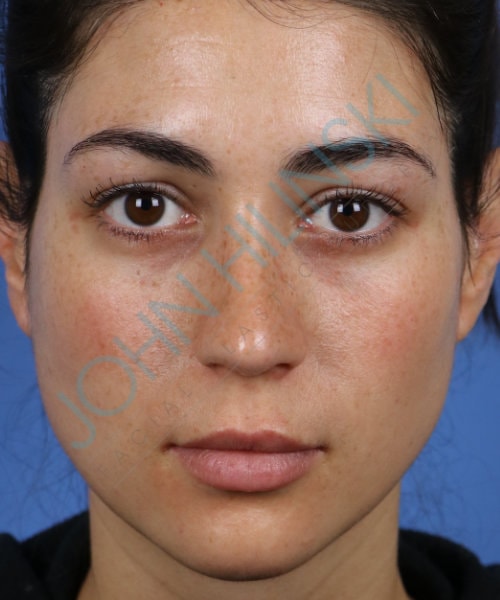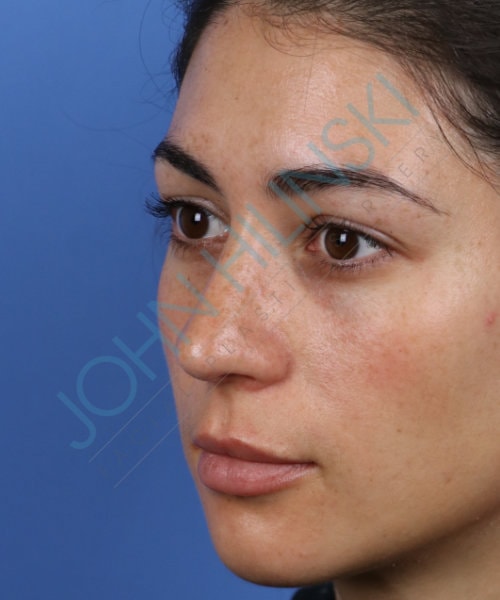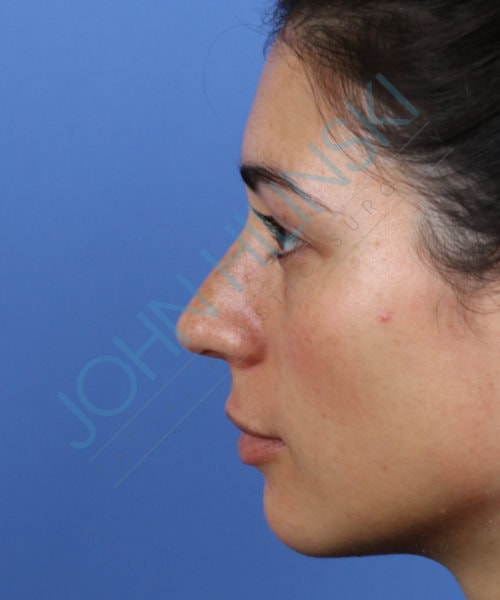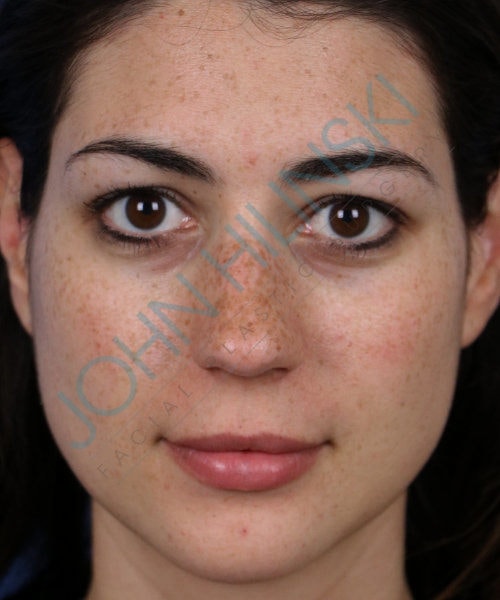 This is a great case study on how Dr. Hilinski used great rhinoplasty technique to narrow this San Diego lady’s broad, wide nose. She consulted with Dr. Hilinski and noted how unhappy she was with the bulbous, wide nasal tip. When you looked closely at her nasal tip region, one could readily see how the nasal tip was lacking in definition.
This is a great case study on how Dr. Hilinski used great rhinoplasty technique to narrow this San Diego lady’s broad, wide nose. She consulted with Dr. Hilinski and noted how unhappy she was with the bulbous, wide nasal tip. When you looked closely at her nasal tip region, one could readily see how the nasal tip was lacking in definition.
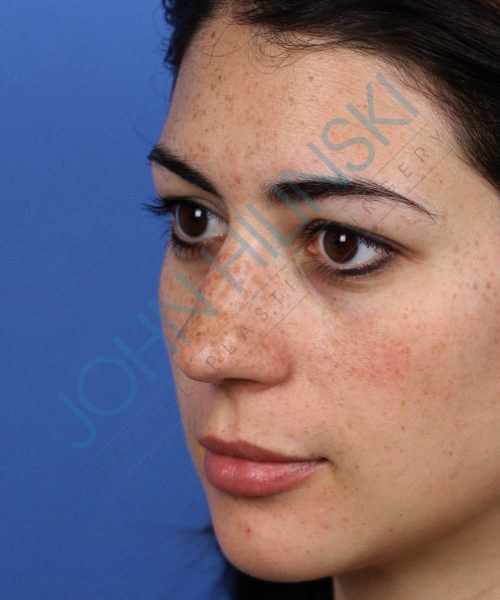
In addition, she had fairly wide, or splayed, nasal bones. She has obvious freckling of the nose that helps in ‘mapping’ out the actual width of her nose. In this particular case, her nasal bones were nearly as wide as the nasal base – which should not be the case. Ideally, the nasal bones will be more narrow than the nasal base – contributing to a nice, elegant brow-tip aesthetic line along the bridge of the nose.
When looking at the oblique view of her nose, you can see just how broad and wide her nose really is from this angle. Although she doesn’t have something like a huge nasal hump deformity or drooping nasal tip, she was still a great candidate to undergo finesse rhinoplasty surgery by Dr. Hilinski.
Intraoperative Rhinoplasty
 Once in surgery, Dr. Hilinski was able to readily see just how bulbous her nasal tip was when he saw the lower lateral cartilages that comprise the nasal tip. This is seen here in the adjacent photo taken during the actual nose job surgery.
Once in surgery, Dr. Hilinski was able to readily see just how bulbous her nasal tip was when he saw the lower lateral cartilages that comprise the nasal tip. This is seen here in the adjacent photo taken during the actual nose job surgery.
As you can see, her nasal tip cartilages were, indeed, quite rounded and broad. They almost appear as two arches. Their overall outline is far from the ideal shape of a soft triangle. Instead, they form more of an overall trapezoidal shape to the nasal tip. No wonder her nose appeared so wide and bulbous from the frontal view! Dr. Hilinski ended up performing quite a bit of change to her nasal tip to make it more narrow and defined. But he was quite careful in making sure that she did not develop any unwanted pinching or collapse as a result of the nose job.
 During the rhinoplasty surgery, Dr. Hilinski also focused his attention on making the nasal bones more narrow. This is a common nose job maneuver and is referred to as osteotomies. This is essentially breaking of the nasal bones to bring them in closer together. The smeared purple markings in the adjacent photo correspond to the where the lateral cuts were made to break her nasal bones. These are the bone cuts on the side of the nose that allow the rhinoplasty surgeon to really move the bones inward. There is obviously some degree of surgical swelling seen in the photo – but you can still tell how her nasal bones are nicely narrowed on the operating room table. If you look at her nasal tip you can also appreciate how it has been defined and refined on the operating room table.
During the rhinoplasty surgery, Dr. Hilinski also focused his attention on making the nasal bones more narrow. This is a common nose job maneuver and is referred to as osteotomies. This is essentially breaking of the nasal bones to bring them in closer together. The smeared purple markings in the adjacent photo correspond to the where the lateral cuts were made to break her nasal bones. These are the bone cuts on the side of the nose that allow the rhinoplasty surgeon to really move the bones inward. There is obviously some degree of surgical swelling seen in the photo – but you can still tell how her nasal bones are nicely narrowed on the operating room table. If you look at her nasal tip you can also appreciate how it has been defined and refined on the operating room table.
Early Rhinoplasty Recovery
As with most of his nose job patients, Dr. Hilinski saw her on a regular basis after her rhinoplasty procedure. When Dr. Hilinski breaks a nose, he likes to see patients several times within the first few weeks so he can assess how the nasal bones are positioned. There is actually a window of opportunity within the first 6-9 weeks after a nose job where the nose bones are still mobile – before they fuse and heal in place.
 During this early rhinoplasty recovery period, patients can push or press on the nasal bones to help get them in an even more optimal position. Dr. Hilinski calls these ‘digital pressure exercises’ for rhinoplasty patients. Although the nasal cast is placed at the end of the nose job to help keep the bones in their new position, inevitably some rhinoplasty patients will see their bones move once the cast comes off. This is not in the majority of cases, but it can occur in a minority of rhinoplasty patients. When it does occur, Dr. Hilinski will likely recommend the digital pressure exercises to try and get the best rhinoplasty result possible. In some cases, nose job patients will push on both sides of the nose. In others, Dr. Hilinski will have patients only pushing on one side of the nose – or more on one side of the nose. Dr. Hilinski will show you in the office how to do these exercises properly. Do not attempt to to do these independent of an expert nose job surgeon’s recommendations – or you will risk damaging your nose.
During this early rhinoplasty recovery period, patients can push or press on the nasal bones to help get them in an even more optimal position. Dr. Hilinski calls these ‘digital pressure exercises’ for rhinoplasty patients. Although the nasal cast is placed at the end of the nose job to help keep the bones in their new position, inevitably some rhinoplasty patients will see their bones move once the cast comes off. This is not in the majority of cases, but it can occur in a minority of rhinoplasty patients. When it does occur, Dr. Hilinski will likely recommend the digital pressure exercises to try and get the best rhinoplasty result possible. In some cases, nose job patients will push on both sides of the nose. In others, Dr. Hilinski will have patients only pushing on one side of the nose – or more on one side of the nose. Dr. Hilinski will show you in the office how to do these exercises properly. Do not attempt to to do these independent of an expert nose job surgeon’s recommendations – or you will risk damaging your nose.
The adjacent photo is the same patient only weeks out from her nose job by Dr. Hilinski. As you can easily see, her nose is quite puffy and swollen. This is not unusual, which is why Dr. Hilinski is showing this type of photo here. Some patients should expect their nose to be this swollen even weeks out from surgery. Some are not as swollen – and others are even more puffy after rhinoplasty. But be prepared.
When Dr. Hilinski saw her at this point in his San Diego office, he recommended she begin doing the digital exercises for nose job patients. He guided her to the exact technique and recommended she do this 10-15 x per day to try and get her nasal bones in a more ideal position after breaking her nose.
Wide Nose Rhinoplasty Results
Fast forward to her long-term results and you can very easily see just how much change happened with her nose job. Looking at her nose from all these angles, you can readily see how it just looks smaller in size – and that is because it is a smaller nose! More specifically, the nose tip has been defined and narrowed – yet doesn’t look pinched and fake. And her nasal bones have been brought in very nicely by Dr. Hilinski. On the oblique view, you can even see how the nose is overall smaller in size. The nose tip is no longer bulbous in shape and the bridge is sleeker in appearance. Her side view did not change a whole lot – but you can even see here how the nose is more refined. Looking back at her nose job photos from just weeks out from Dr. Hilinski’s rhinoplasty, you see how much swelling has gone down and how the skin has truly shrunk wrap around the new smaller nose size. Look even closer at the nasal bones on her front view and you can appreciate the difference between where her nose was a few weeks out and how it looks after appropriate amount of time to heal.

